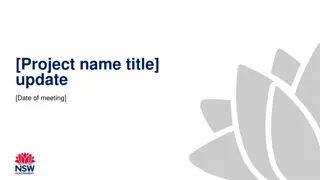Strategy Update on Winter SISCO Project in Kamloops, BC
The strategy update for the Winter SISCO project in Kamloops, BC highlights the progress made in various areas and key learnings. Prioritizing rehabilitation treatments over fertilization due to potential merchantable volume benefits, the update delves into technical analysis, planning processes, and addressing information gaps. Key insights from web meetings shed light on the reasoning behind treatment strategies for different stands. The analysis emphasizes long-term benefits and cost-effectiveness considerations.
Download Presentation

Please find below an Image/Link to download the presentation.
The content on the website is provided AS IS for your information and personal use only. It may not be sold, licensed, or shared on other websites without obtaining consent from the author.If you encounter any issues during the download, it is possible that the publisher has removed the file from their server.
You are allowed to download the files provided on this website for personal or commercial use, subject to the condition that they are used lawfully. All files are the property of their respective owners.
The content on the website is provided AS IS for your information and personal use only. It may not be sold, licensed, or shared on other websites without obtaining consent from the author.
E N D
Presentation Transcript
February 25, 2014 Type 4 Strategy Update Winter SISCO Winter SISCO - Kamloops. BC What s done and what have we learned . 1
Update Complete or Near Complete: Quesnel Williams Lake Lakes Okanagan Morice 100 Mile Prince George Just Started Kamloops On Radar for 2014 Invermere, Cranbrook, Strathcona, Arrow August 16, 2013 For More Info: http://www.for.gov.bc.ca/ HFP/silstrat/index.htm Web Meeting 2
What Have We Learned: Ideas Fall into Three Broad Themes 1. Technical Analysis / Solutions 2. Planning Process 3. Information Gaps August 16, 2013 Web Meeting See abstract for details lets dig into just one of them here: Fertilization vs Rehabilitation Treatments which one? 3
Quesnel and Williams Lake TSAs Prioritize Rehab Treatments in short term because Fert Treatments can wait (but do both). August 16, 2013 Preferred Strategy Expenditures (Williams Lake) Web Meeting 4
Why Rehab over Fert? Rehab has potential to provide merchantable volume for mills at the time of treatment AND increase the effective landbase in the long term. Example a dead Pl stand with 35m3/ha of green spruce scattered throughout is currently uneconomic and not expected to amount to much in next 80 years. If rehabbed now (FLTC or ITSL) it provides 35 m3/ha of merch volume into the timber supply + capture the sites potential with a new managed stand. Costs to treat are offset by realized merch volume. August 16, 2013 Web Meeting 5
Why is Fert Lower Priority? Limited number of currently suitable stands. Risk of loss reduced and ROI increased when fert done closer to harvest. Still plenty of time to treat stands prior when they will be harvested (midterm). Example in fires t August 16, 2013 Web Meeting 6
Fertilization vs Rehabilitation Fertilization Rehabilitation August 16, 2013 +15m3/ha in 10 yrs Cost is $450/ha Re-establish stands rendered uneconomic by MPB related mortality with + ~30m3/ha now? +100m3/ha in 60 yrs Cost is $1000-2000/ha Web Meeting 7
Base Case Review Short term: 3.2 M Midterm: 1.8 M Long term: 3.6 M August 16, 2013 Midterm: Yrs10-50 91% Pl in Yrs 1-5 Web Meeting Lowest Point of Available Growing Stock is in Years 30-50. 8
Base Case Review Salvage in first two periods. August 16, 2013 Small but important role for IDF. Web Meeting Transition to managed stands starts in 20 yrs. Heavily reliant by 40 yrs. 9
Base Case Review Most >60% dead stands salvaged leaving lesser impacted stands for Midterm August 16, 2013 Web Meeting Youngest stand profile (smallest timber) harvested between 30-50 yrs 10
Base Case Review August 16, 2013 Web Meeting Average harvest volume in short term is 100m3/ha and then improves. Average harvest age is ~90 years in the long term but gets a low as 68 in year 50. Harvest area is very high during salvage period (30,000 ha/yr) but reaches a long term average of 15,000 ha/yr. 11
BASE CASE SENSITIVITIES August 16, 2013 Web Meeting Harvest Flows Min Harvest Volumes Shelf Life Min Harvest Ages 12
Alternative Base Case Harvest Flows August 16, 2013 Web Meeting Alternative approaches to short term harvesting can yield different outcomes in the midterm. Avoiding the harvest of stands that remain viable in the midterm improves the midterm but foregoes the economic value of the pine lost. 13
Sensitivity: Revised Min Harvest Criteria August 16, 2013 Web Meeting Always @80m /ha Short (+12%) Mid (+21%) Rise (+13%) Long (+5%) Always @110m /ha Short (-4%) Mid (-9%) Rise (-1%) Long (-6%) 14 Base Case: 80 m /ha for salvage, 110 m /ha for second growth
Sensitivity: Revised Shelf-Life August 16, 2013 Web Meeting 15
Sensitivity: Revised Shelf-Life August 16, 2013 Web Meeting Short (+15%) Mid (~) Rise (+23%) Long (+5%) 16
Sensitivity: Longer MHAs (Quesnel Ex) August 16, 2013 Web Meeting 17
Sensitivity: Longer MHAs August 16, 2013 Web Meeting 18
Sensitivity: Deciduous Currently very little utilization of deciduous material Estimate opportunity Deemed lower priority August 16, 2013 Web Meeting 19
Sensitivity: Limit the Harvest of Small Pine Harvesting small pine becomes less economic with longer haul distances Deemed lower priority not completed August 16, 2013 Web Meeting 20
Key Points: Base Case and Sensitivities WL TSA is heading towards a low in available volume after the 4th decade (29.3 MM m ) Harvest forecasts are very sensitive to: Salvage effort and stand types salvaged Shelf-life Minimum harvest criteria (MHA) August 16, 2013 Web Meeting 21
SILVICULTURE STRATEGIES August 16, 2013 Web Meeting 22
Strategy: Fertilization Incremental volumes achieved after 10 yrs (single or multiple treatments) Pl @ 12m /ha Fd @ 15m /ha Sx @ 15m /ha (Mulitple Sx fertilization done every 5 yrs, with larger gains) August 16, 2013 Area Treated Over Time Web Meeting 23
Strategy: Fertilization August 16, 2013 Web Meeting Budget maximized after 15 years The model harvests all stands that are treated and does not treat stands that are not harvested. Half of volume harvested in midterm is comes from natural stands. Multiple Sx fertilization is prioritized (most cost efficient). 24
Strategy: Fertilization August 16, 2013 Web Meeting Short (~) Mid (0-10%) (little to no ACE effect occurs) Rise (+5%) Long (+8%) 25
Strategy: PCT and Fertilize Relatively little area eligible (6,800 ha) Lower priority than to fertilize existing stands with appropriate density higher cost and gain is similar. Low priority dropped August 16, 2013 Web Meeting 26
Strategy: Spacing Dry-Belt Fd (Thinning young thickets in NonUWR stands 10% volume increase at harvest August 16, 2013 Area Treated Web Meeting $ s Spent 27
Strategy: Spacing Dry-Belt Fd August 16, 2013 Web Meeting Short (~) Mid (+3%) Rise (+1%) Long (not investigated) Delayed response as have to wait 30 yrs after treatment to harvest. 28
Strategy: Rehabilitation Reforest MPB impacted stands that are non-merch (<80m3/ha) August 16, 2013 Area Treated Web Meeting $ s Spent 29 Extensive opportunity, full budget spent (~1,500 ha/yr).
Strategy: Rehabilitation August 16, 2013 Web Meeting Short (~) Mid (+8%) - volume at time of treatment + some THLB back in Rise (+13%) Non merch stands brought back into production Long (+13%) Non merch stands brought back into production 30
Strategy: Partial Cut in Constrained Areas Harvest of 1/3 volume in constrained areas, no impact to non timber values August 16, 2013 Area Treated Web Meeting $ s Spent 31
Strategy: Partial Cut in Constrained Areas August 16, 2013 Web Meeting Short (~) Mid (+14) Rise (no attempt to improve) Long (no attempt to improve) Significant improvement in midterm due to accessing stands that would otherwise not be available. 32
Strategy: Enhanced Basic Reforestation Improved well-spaced densities, fewer gaps ( OAF1), more planting / class A seed August 16, 2013 Area Treated Web Meeting $ s Spent 33 Budget max reached in several periods, about 70% of stands logged in midterm get enhanced reforestation.
Strategy: Enhanced Basic Reforestation August 16, 2013 Web Meeting Short (~) Mid (+5%) Rise (+2%) Long (+12%) First stands are ready in 35-45 years as min harvest volumes are reached sooner. 34 Mid and long term benefit from enhanced yields. Little to no ACE effect.
Optimized Mix $3 Million/yr Budget Area Treated $ s Spent August 16, 2013 Web Meeting Budget max reached every year Rehab and Enhanced Basic are dominant initially (first 5 yrs) Fertilization ramps up over time (almost all eligible stands treated before harvest) Majority of the budget spent on Rehab in all time periods Partial cutting is key to improving early midterm. Spacing of drybelt Fd is a focus in early periods. 35
Optimized Mix $3 Million/yr Budget August 16, 2013 Web Meeting Short (~) Mid (+22%) Rise (+2%) Long (+11%) Midterm increased as priority over longterm. 36
Optimized Mix $5 Million/yr Budget Area Treated $ s Spent August 16, 2013 Web Meeting Budget max reached every year (5 Million) Treatment decisions very similar to 3 million budget. Heavy spending on rehab Ramp up of fertilization Steady spending on enhanced reforestation Partial cutting to help the front end of the midterm. Most thinning of Drybelt fir in early periods 37
Strategy: Composite Mix @ $5M/yr August 16, 2013 Web Meeting Short (~) Mid (+28%) Rise (+10%) Long (+17%) Midterm increased as priority over longterm. 38
ECONOMIC ASSESSMENT August 16, 2013 Web Meeting 39
Stand-Level Economics - Assumptions 2% discount rate Net economic benefit of $25/m3 on the additional volume realized (net benefit to crown from additional cubic meter harvested and moving through the economy). August 16, 2013 Web Meeting 40
Stand-Level Economics - Results August 16, 2013 Web Meeting Multi Spruce Fert (3-5) most attractive fert option. Rehab, Partial Cut, and Enhanced Basic have positive return at 2%. 41
Forest-Level Economics August 16, 2013 $3M Budget NPV = $122 M $5M Budget NPV = $182 M Web Meeting 42
Forest-Level Economics August 16, 2013 Web Meeting 43
Key Points: Silviculture Strategies Rehab appears to be the largest opportunity and warrants significant investment. It buys wood in the short term from stands that will never be eligible, plus adds to the long term harvest by putting them into production. Partial harvesting in constrained areas is the only strategy to help fill in the front of the midterm. It borrows volume from later in the forecast (i.e., no extra volume) Fertilization is important but not as time sensitive as other treatments. There are several decades before any of these stands will be harvested so time exists to treat them. Both Composite Scenarios (3M and 5M budgets) are similar in treatment selections/proportions and have positive NPV at the forest level (2% discount rate). August 16, 2013 Web Meeting 44
PREFERRED STRATEGY August 16, 2013 Based on the finding shown here and general knowledge of the TSA and its options what is the preferred strategy for the next 5-10 yrs? Web Meeting 45
Optimize $5 M Budget? August 16, 2013 Web Meeting 46
Next Steps and Timing Modelling and Analysis Report Distribute for review - end of August Silviculture Strategy Report Distribute for review end of August Tactical Plan Deferred August 16, 2013 Web Meeting 47
August 16, 2013 Web Meeting 48
Harvest Flow Differences Base Case 2762000 1767000 Change relative to Base Case (m /yr) 2793000 3578000 August 16, 2013 Scenario Short-Term Mid-Term Rise to Long-Term Long-Term Sample (4,000) 0% (3,000) 0% Fertilization of Sx, Pl, Fd 2,000 0% 42,000 2% 138,000 5% 297,000 8% Spacing dry-belt Fd 50,000 3% 15,000 1% - 0% Web Meeting Rehabilitation 147,000 8% 353,000 13% 463,000 13% Enhanced Basic Reforestation (4,000) 0% 83,000 5% 69,000 2% 433,000 12% Partial cut in constrained areas (4,000) 241,000 14% (8,000) 0% (2,000) 0% Combined Silviculture ($3 M/yr) (4,000) 0% 140,000 8% 202,000 7% 595,000 17% Combined Silviculture ($5 M/yr) (4,000) 0% 237,000 13% 290,000 10% 865,000 24% 49























